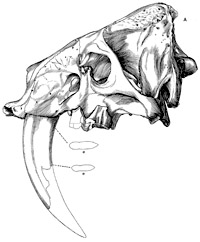Museum, University of Nebraska State
Date of this Version
11-1948
Document Type
Article
Citation
BULLETIN OF THE UNIVERSITY OF NEBRASKA STATE MUSEUM, VOLUME 3, No. 4, Parts 1 & 2. NOVEMBER 1948
Abstract
PALEONTOLOGICAL and archaeological discoveries were made near Cambridge, Nebraska, by the University of Nebraska State Museum field party in the spring of 1947 (Schultz and Frankforter, 1948, pp. 279-280) . Fossils and artifacts were found in situ at the base of a fifty-foot terrace on Lime Creek (University of Nebraska State Museum Localities Ft-41 and Ft-42) and on Medicine Creek just below the mouth of Lime Creek (Ft-50). Lime Creek is located (Fig. 1) in southwestern Nebraska in the southeastern part of Frontier County. It is a tributary of Medicine Creek which in turn is a tributary to the Republican River.
The paleontological material from this site reveals new information on the Pliocene-Pleistocene boundary line problem-a fundamental problem in the over-all Pleistocene history of the region. A series of five topographic benches' or terraces is developed (see Figs. 4 and 5) along the Republican River and its tributaries. Field studies indicate that these represent cycles of alluviation interrupted by erosional periods. A similarly developed series of terrace-fills in a contiguous region has been provisionally correlated with the sub-stages of the Wisconsin stage of Pleistocene continental glaciation (Lueninghoener, 1946).
I N THE natural course of paleontological and geological explorations in Pleistocene deposits the fossil hunter often discovers evidence of man's early occupation of North America. Artifacts and other cultural evidence are frequently found in direct association with the fossilized bones of various species of animals. Some of these remains represent extinct species while others can be referred to those found in North America today. Much is yet to be learned concerning the stratigraphic distribution of vertebrate life of the Pleistocene and the time of extinction of certain forms, but new evidence (see Schultz, Lueninghoener, and Frankforter, Part 1, Fig. 6 of this report) is constantly being accumulated which aids in clarifying the picture. In 1932 the University of Nebraska State Museum commenced a research program (Lugn, 1934, pp. 319-356; Schultz, 1934, pp. 357-393) in the field and laboratory relating to the stratigraphic distribution of the Pleistocene mammals and the study of extinction in the Great Plains. Since that time the major portion of the Museum's field work has been directed to problems relating to the Pleistocene. The significance of terraces to the problems has been pointed out in Part 1 of this report (also in Schultz and Stout, 1945; 1948).
Included in
Entomology Commons, Geology Commons, Geomorphology Commons, Other Ecology and Evolutionary Biology Commons, Paleobiology Commons, Paleontology Commons, Sedimentology Commons


Comments
Copyright (c) 1948 University of Nebraska.